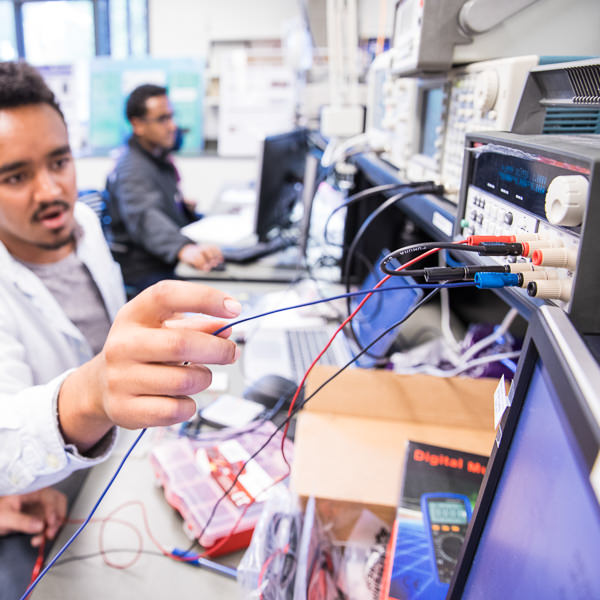Curriculum
Graduate certificate courses
Build fundamental electrical engineering skills in a nine-month, six-course sequence. Get introduced to tools, industry-standard simulation software and techniques used to solve engineering challenges. Study part time in the evening, taking two classes a quarter.
Learn the theory, design, analysis, and application of DC and AC circuits. Develop an understanding of digital logic, characteristics and applications of electronic devices, power system analytical concepts and the representation and classifications of continuous and discrete time signals.

Study embedded systems from hardware and software perspectives and how they interact to accomplish real-world tasks.
Course schedule
Students meet on-campus twice a week on Mondays and Wednesdays in the evenings. Graduate certificate classes build upon what students learn each quarter. In addition to course content, students will have weekly homework and/or lab work outside of class. FAQ about time commitment. Students need to complete each course with a 2.7 or higher, and maintain a cumulative 3.0 to earn the graduate certificate.
Autumn 2024
| Course | Cr | Days |
|---|---|---|
| B EE 503: DC Circuit Analysis and Applications | 3 | M/W |
| B EE 505: Digital Systems | 3 | M/W |
Winter 2025
| Course | Cr | Days |
|---|---|---|
| B EE 506: AC Circuits and Power (prerequisite: B EE 503) | 3 | M/W |
| B EE 507: Signals and Systems (prerequisite: B EE 503) | 3 | M/W |
Spring 2025
| Course | Cr | Days |
|---|---|---|
| B EE 504: Device Electronics (prerequisite: B EE 503) | 3 | M/W |
| B EE 508: Introduction to Embedded Systems (prerequisites: B EE 503 and 505) | 3 | M/W |
Course descriptions
B EE 503 DC Circuit Analysis and Applications
DC circuit analysis using various circuit laws, theorems and methods. Topics covered: voltage-current characteristics of basic circuit elements; equivalent resistance of circuits; circuit analysis using Ohm’s law and Kirchhoff’s laws; Thevenin and Norton equivalent circuits; superposition theorem; nod voltage and mesh current methods; transient response of first and second order circuits; and introduction to operational amplifiers.
An introduction to characteristics and application of three electronic devices: diodes, field-effect and bipolar junction transistors. Topics include characteristics of the devices, small-signal and large-signal analyses. (Prerequisite: BEE 503)
An introduction to methods and techniques for designing basic digital circuits and systems. Topics include: logic circuits and Verilog; circuit minimization using Boolean algebra and Karnaugh maps; combinational circuit design; multiplexers and decoders; latches and flip flops; registers and counters; sequential circuits; and implementation of digital circuits in an FPGA using Verilog.
B EE 506 AC Circuits and Power
An introduction to AC circuits and power systems. Topics covered include: analysis of circuits using phasors; power computations in ac circuits and frequency response of circuits; power transformers; synchronous generators; three-phase circuits; and Laplace transforms in circuit analysis. (Prerequisite: B EE 503)
An introduction to the mathematical representation, analysis and classification of continuous-time and discrete-time signals and systems. Topics covered include: time domain analysis of Linear Time Invariant (LTI) systems; Fourier Transform for continuous-time and discrete-time signals and systems; digital filters; and introduction to Z-transform. (Prerequisite: B EE 503)
B EE 508 Introduction to Embedded Systems
An introduction to embedded systems from a hardware and software perspective and how they interact to accomplish real-world tasks. Topics covered include: microprocessor organization; number systems and basic arithmetic operations for microprocessors; basic assembly and embedded C programming; memory, interrupt, and input/output peripheral interfaces; and microprocessor-based system design. (Prerequisite: B EE 503 and 505)